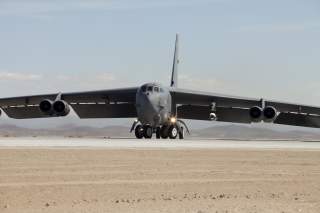New Air Force Study Warns of Chinese Hypersonic Weapons
The US wants to stay in front of China with hypersonic weapons able to travel at five-times the speed of sound and destroy targets with a "kinetic energy" warhead.
While much progress has been made by Air Force and Pentagon scientists thus far, much work needs to be done before hypersonic air vehicles and weapons are technologically ready to be operational in combat circumstances.
The Air Force is aggressively accelerating its hypersonic weapons development effort, following findings from a recent service report identifying Russian and Chinese ongoing hypersonic weapons testing.
A recent Air Force Studies Board report identified that the U.S. is not alone in its quest for this increased speed, an Air Force statement said.
The statement went on to say that China and Russia are already flight testing hypersonic weapons, and several other countries have shown interest in pursuing many of the underlying technologies for hypersonic flight.
“We must push the boundaries of technology in every area," Air Force Chief of Staff Gen. David L. Goldfein said in a statement. "Our adversaries aren’t standing still. They are looking for every advantage they can get.”
While expressing growing concern about Russian and Chinese hypersonic weapons progress, US developers have been progressing with hypersonic flight and hypersonic weapons possibilities for several years.
Describing the trajectory of hypersonic technology in terms of “stair steps,” Air Force Chief Scientist Geoffrey Zacharias said incremental progress will require decades of continued technological development.
While unmanned hypersonic surveillance flight is on track for the 2030s, launching recoverable hypersonic drones is not expected be possible until the 2040s, Zacharias said in an interview with Scout Warrior.
Air Force weapons developers expect to operate hypersonic intelligence, reconnaissance and surveillance drones by the 2040s, once scientific progress with autonomy and propulsion technology matures to a new level.
The advent of using a recoverable drone platform able to travel at high altitudes, faster than Mach 5, will follow the emergence of hypersonic weapons likely to be operational in the mid-2020s.
By the 2040s, however, the Air Force could very well have a hypersonic “strike” ISR platform able to both conduct surveillance and delivery weapons, he added.
Hypersonic Weapons Technology
Since hypersonic vehicles can travel in a parabola-type flight path, they rise very high up into the atmosphere to reach hypersonic speeds before returning to lower altitudes.
Developing recoverable drones is much more challenging given the level of autonomy and re-entry needed for hypersonic vehicles to descend and perform ISR missions.
“A booster sends it into the atmosphere and then it dives down to its target,” Zacharias said. “A re-entry vehicle would need to be maneuverable with sufficient wing area so it can avoid counter-missiles. We need to design that chamber and make it stable to allow for maneuver.”
The advantages of hypersonic ISR drone flight are multifaceted.
“You could fuel one of these to go for 1,000 miles in ten minutes. It speeds up the kill chain,” he said.
Hypersonic drones could quickly reach long-range targets to perform a variety of missions such as testing enemy air defenses, surveillance missions and even precision strike operations. These drones could identify far away targets much faster while ensuring that manned aircraft remain at a safe distance.
While today's cruise missiles travel at speeds up to 600 miles per hour, hypersonic weapons will be able to reach speeds of Mach 5 to Mach 10, Air Force officials said.
A weapon traveling at hypersonic speeds, naturally, would better enable offensive missile strikes to destroy targets such as enemy ships, buildings, air defenses and even drones and fixed-wing or rotary aircraft depending upon the guidance technology available.
Last year, the Air Force launched several hypersonic speed “test flights” as part of a joint program with Australia.
Some of the remaining scientific challenges to sustaining hypersonic drone flight include developing an ability for vehicles to operate at very high temperatures, Zacharias said.
The Air Force will likely have high-speed, long-range and deadly hypersonic weapons by the 2020s, providing kinetic energy destructive power able to travel thousands of miles toward enemy targets at five-times the speed of sound.
“Air speed makes them much more survivable and hard to shoot down. If you can put enough fuel in them that gets them a good long range. You are going roughly a mile a second so if you put in 1,000 seconds of fuel you can go 1,000 miles - so that gives you lots of standoff capability,” Zacharias said.
While much progress has been made by Air Force and Pentagon scientists thus far, much work needs to be done before hypersonic air vehicles and weapons are technologically ready to be operational in combat circumstances.
“Right now we are focusing on technology maturation so all the bits and pieces, guidance, navigation control, material science, munitions, heat transfer and all that stuff,” Zacharias added.
A super high-speed drone or ISR platform would better enable air vehicles to rapidly enter and exit enemy territory and send back relevant imagery without being detected by enemy radar or shot down.
A weapon traveling at hypersonic speeds, naturally, would better enable offensive missile strikes to destroy targets such and enemy ships, buildings, air defenses and even drones and fixed-wing or rotary aircraft depending upon the guidance technology available.
This first appeared in Scout Warrior here.

